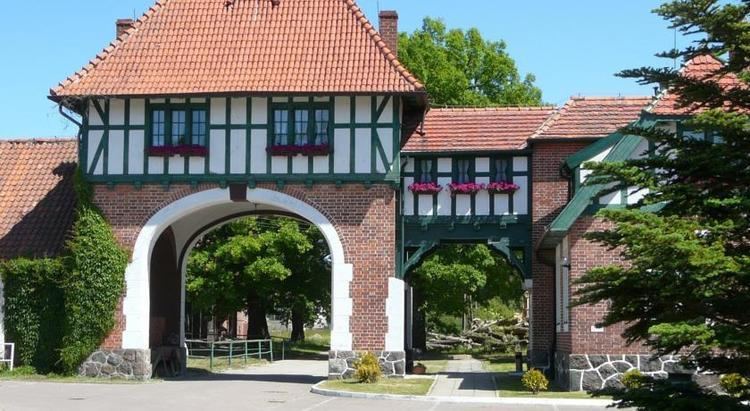Local time Friday 4:13 PM | Population (approx.) 600 | |
 | ||
Weather 5°C, Wind W at 14 km/h, 94% Humidity Voivodeship Warmian-Masurian Voivodeship | ||
View of the vistula lagoon from kadyny poland
Kadyny [kaˈdɨnɨ] (German: Cadinen or Kadinen) is a village of Gmina Tolkmicko, within Elbląg County, Warmian-Masurian Voivodeship, in northern Poland.
Contents
- View of the vistula lagoon from kadyny poland
- Map of Kadyny Poland
- Geography
- History
- Notable people
- References
Map of Kadyny, Poland
Geography
It is situated in the Elbląg Upland Landscape Park, a protected area on a terminal moraine stretching along the Vistula Lagoon of the Baltic Coast. The Bażyński Oak in the village is one of the oldest trees in Poland.
Kadyny lies approximately 4 kilometres (2 mi) south-west of Tolkmicko, 24 km (15 mi) north of Elbląg (German: Elbing), and 88 km (55 mi) north-west of the regional capital Olsztyn. It shares a border with the village of Łęcze to the south. The village has an approximate population of 600.
Kadyny Station is a stop on the former Vistula Lagoon railway line (Kolej Nadzalewowa) from Elbląg to Braniewo, which is to be re-activated by the private Arriva RP rail carrier.
History
The terra Cadinensis in Prussia was first mentioned in a 1255 deed. It was allegedly named after Cadina, a daughter of an Old Prussian chief. Actually Old Prussian kudas means "hardship" or "wilderness". Named Kudien in 1354, the Teutonic Knights of the Elbing commandry had built a Vorwerk estate near the site of a former Prussian fortress, where they held court over the native Pogesanian inhabitants in the area. From 1431 the Cadinen manor was owned by Johannes von Baysen, leader of the Prussian Confederation in the Thirteen Years' War against the Teutonic Knights under Grand Master Ludwig von Erlichshausen.
With the 1466 Second Peace of Thorn it became part of Royal Prussia and thus politically Polish. The Baysen noble family finally sold Cadinen in 1605. With Royal Prussia, it was annexed by the Kingdom of Prussia during the First Partition of Poland in 1772, incorporated into the West Prussian Regierungsbezirk of Danzig from 1815. The German emperor Wilhelm II acquired Cadinen Manor in 1898 and had it rebuilt as his summer residence. A successful Maiolica tile factory was established there in 1905, and many of those tiles were used to decorate the Old Elbe Tunnel in Hamburg and several Berlin U-Bahn stations. Wilhelm also had a breeding site for Trakehner horses established and the village developed as a fashionable seaside resort. After World War I and the 1919 Treaty of Versailles, Cadinen remained part of the German Province of East Prussia and a property of the House of Hohenzollern until their expulsion in 1945. Prince Louis Ferdinand of Prussia (1907–1994), who lived there during World War II, was the last Hohenzollern to reside here.
Following World War II the native German populace was expelled and replaced by Poles. Since 1945, when the area was turned over to the Republic of Poland according to the Potsdam Agreement, it has been called Kadyny. Today the estates are managed as a cultural heritage site and popular tourist destination.
Notable people
Princess Marie Cécile of Prussia (born 1942) and Princess Kira of Prussia (1943–2004), daughters of Prince Louis Ferdinand of Prussia and his wife Grand Duchess Kira Kirillovna of Russia (1909–1967) were born in Cadinen.
